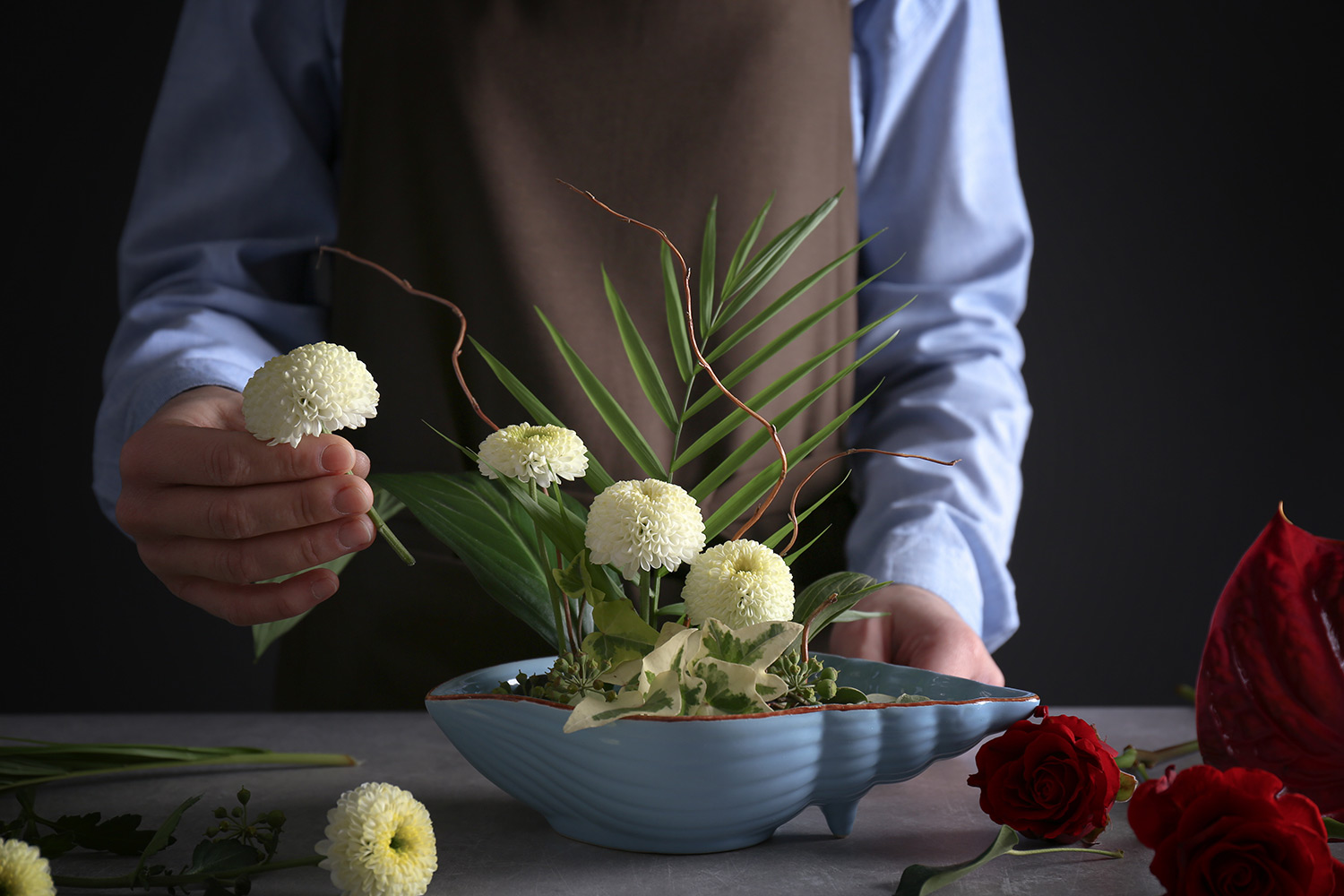

IKEBANA, OR JAPANESE ART OF FLOWER ARRANGING
Japanese flower arrangement
In the Western culture, Ikebana usually functions as the Japanese art of arranging lowers. Rarely does this term fully reflect the symbolic nature of the Asian tradition, which combines aesthetic sensitivity, knowledge of the environment and the search for connection with the mystical world of nature. Its essence is more than just physical works of the flower craft – it is also, or primarily, the process of their creation. Due to the time devoted to careful selection of sizes, colours and shapes, Ikebana becomes a form of meditation on the natural cycle of life, seasons of the year, transience and fragility of human existence.
The history of Ikebana
Ikebana is a branch of Japanese art that shows the originality and uniqueness of a culture thriving in insular isolation. Its history dates back to approximately the 6th century A.D., to the introduction of Buddhism in Japan. Even though the roots of Ikebana are to be sought in the home country of Buddha, it is hard to find the influence of other Asian cultures in the art developing for ages. Over the next centuries, Japanese monks nurtured the flower tradition and followed their own intuition, letting it develop naturally. Finally the florist expertise of the Japanese was organised by, Senkei Ikenobou, a 15th century Buddhist priest, known as the precursors of Ikebana, which was officially recognised as a field of art. The school he founded (Ikenobō-ryū) has been educating masters of flower arrangements for forty five generations, following the rikka style – the most class and the oldest Ikebana styles.
Flower Ikebanas
The structure of every traditional florist work is based on three basic Yakueda lines: Soe, Tai and Shin, which symbolise heaven, earth and man respectively. Proper matching and balancing of the elements is a metaphor of man’s harmony with nature, which should characterise both the flower arrangements and human life.
Ikebana styles
Rikka – “standing flowers.” The basic and the oldest Ikebana style, initially decorating Buddhist temples and the rich interiors of imperial courts, is still the most popular choice for important celebrations, such as Japanese New Year. This is connected with the official and highly rigorous nature of rikka and their large size – classic compositions may be even 1.5 m high. They are usually created from a combination of pine, cypress and cedar, complemented by chrysanthemums and bamboo. Particular elements are arranged in high, narrow vases to create an illusion that they have one stem. The primary rule of the style created by Ikenobo is symmetry.
Seika or shoka. Another classic style, which is based on a triangle formed of the vertices of the main Ikebana elements. Compositions in low vases are usually made of lilies, roses and cast-iron plants. Seika can be created of one (isshuike), two (nishuike) or three (sanshuike) plant species.
Moribana – literally “piled up flowers,” a style focusing on the natural beauty of plants. Small arrangements, usually decorating tables and shelves, are usually made of gladioli, gerbera, chrysanthemums and lilies, whose stems are perfect for being stuck into kenzan – a spiky plate placed at the bottom of a vase. Moribana strictly defines the length and the inclination direction of the flowers, which makes the arrangement process complicated and time-consuming. Due to the diversity of forms, the style is divided into four classes: vertical (variety A), horizontal (B), cascade (C) and class D in two versions. The last variety of moribana particularly stand out. The arrangements created according to its rules resemble miniature landscapes presenting a “natural scenery” or – due to the mirrors placed at the bottom of the vase – “a reflection in the water.”
Heika – unlike moribana, this classic style uses mostly tall, thin vases which guarantee the stability of these fine compositions. Similarly to the previously described variety, heika has four subcategories. The first one (variety A) consists of vertical chrysanthemum structures. The other one (B) – aster arrangements leaning forward. Type C Heika is made mostly of lilies, callas, roses, peonies and tulips, which are diagonally leaning backwards. White and yellow acacia flowers arranged in cascades are characteristic of heika type D.
Ikebana is not just a centuries-long tradition that enchants with its incredible precision but it is a living and thriving field of art. Next to classic, highly formalised styles, it shapes subsequent, contemporary trends of the floral craft. Modern forms of Ikebana that emerged after 1930 include jiyubana, morimono, kakebana, zeneika, jiyuka or gigant. They are mostly characterised by greater freedom in the selection of materials, forms and sizes. Even though they seem to differ from traditional Ikebana works, they prove that the search for harmony with the world of plants keeps stimulating the creative human nature and is an undepletable source of inspirations for man’s artistic endeavours.























